Usnea lichen is a natural antimicrobial that can disinfect wounds and fight off bacterial infections like a boss.
Crafting it into a shelf-stable alcohol tincture is the best way to ensure you have access to this potent plant medicine if disaster ever strikes.
Read on to learn how to make an usnea tincture and turn this fuzzy fruticose lichen into a versatile treatment for whatever ails you.
Materials to Make Usnea Tincture
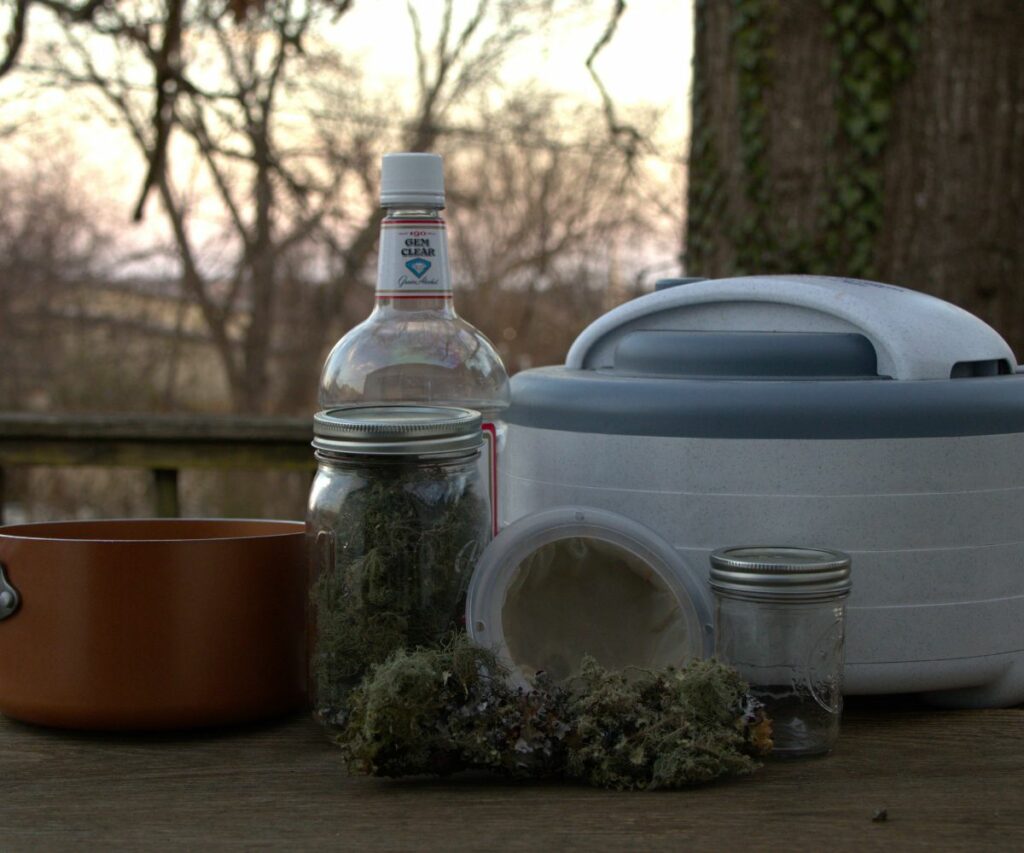
Usnea tincture isn’t hard to make, but it is time-consuming and requires a fair bit of hands-on work. This medicine requires a double extraction, much like a reishi mushroom tincture.
Why all the extra work? Usnea’s polyphenolic compounds are more soluble in water, while its coveted antiseptic usnic acid is more soluble in alcohol. To get the full range of benefits, you’ve got to do both extractions.
To get started, you’ll need the following:
- Usnea lichen: Start with high-quality usnea to make your tincture. I usually use two ounces, but you can use however much you have.
- High-proof alcohol: Act like it’s a college dorm party and go for the cheap stuff. You’ll need 2.5 times as much alcohol as usnea by dry weight.
- Water: Use any source. You’ll need 2.5 times as much water as usnea by weight.
- Mason jars: Have at least three on hand: one to hold your tincture, one to strain it into, and one to use for combining.
- Crockpot or stove pot: Either one will work. I prefer the crockpot since it’s less hands-on and allows for a slower and potentially more thorough extraction.
- Strainer: I use a Toncoo small-particle strainer, which works perfectly for filtering out even small tidbits of plant matter. You could also use cheesecloth.
- Dehydrator (optional): You’ll need to start with dry usnea. You can use a dehydrator like my Nesco Snackmaster or allow your lichens to air-dry.
Making the Usnea Tincture
1. Source Usnea
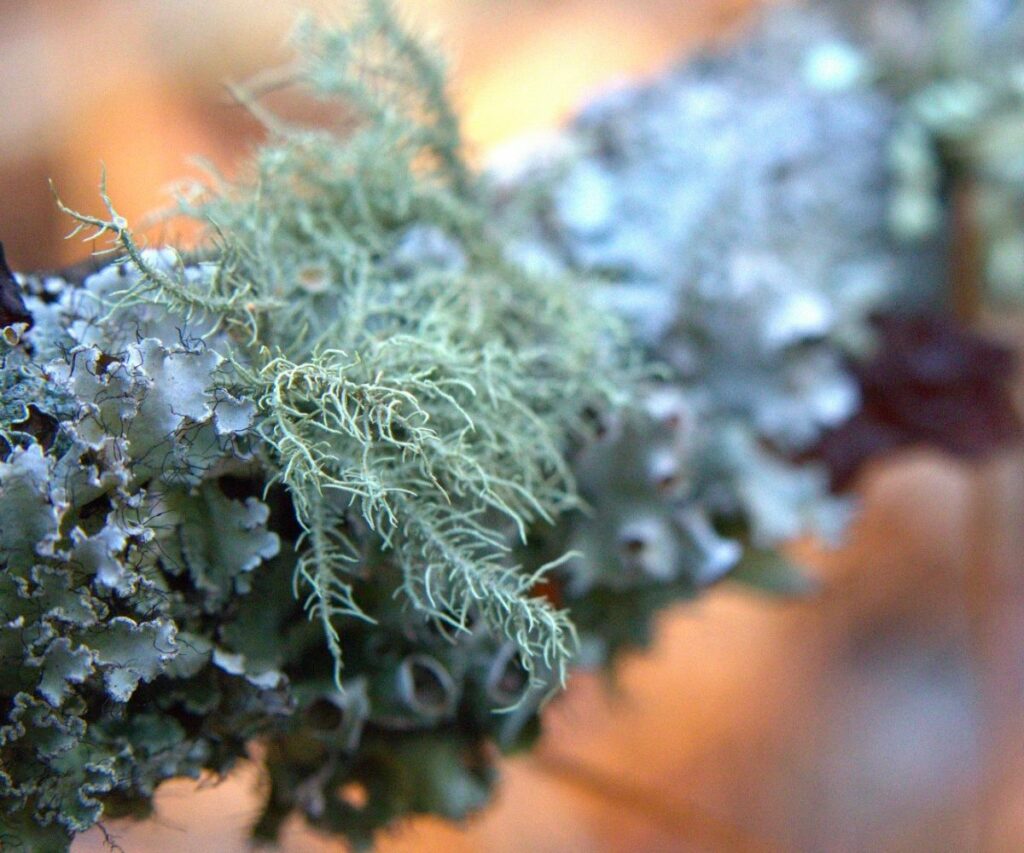
Usnea is a green, coral-shaped lichen that is relatively common and grows in various climates. If it grows in your region, foraging for usnea is pretty easy.
However, usnea is picky. If you live in an urban area or experience a lot of pollution, it won’t grow near you.
In that case, you can buy your lichens online or from a reputable local vendor. I suggest starting with two ounces since it makes measuring everything easier.
2. Clean Usnea
Usnea usually comes cleaned and dried when you buy it. If you forage it yourself, that work falls to you.
Pick off pieces of dirt, bark, and other debris. Do not wash the lichen under water since this will only prolong the time it takes to dry. If there’s a bit of dirt on it, don’t sweat it — you’ll filter it out eventually.
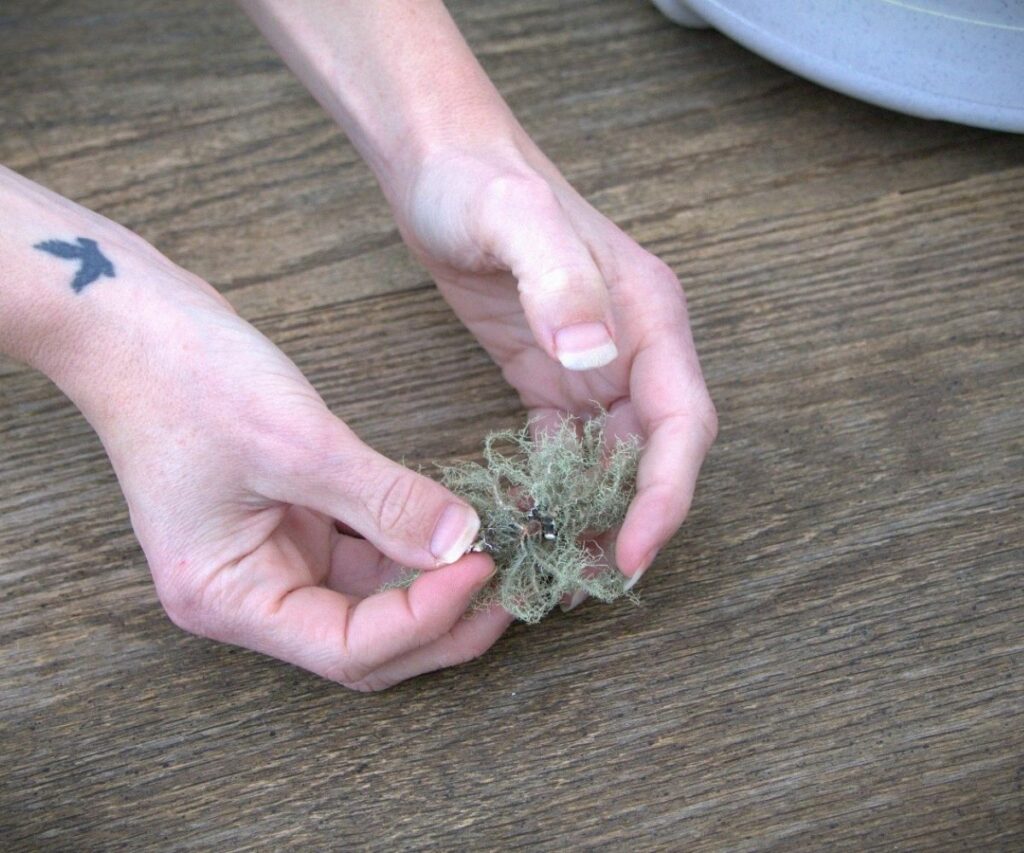
3. Dry Usnea
Once clean, tear or chop the usnea into small pieces and dehydrate it at 130°F for one or two hours. Alternatively, just leave it in the sun for four or five hours.
Optional: You can blend your usnea in an herb grinder or food processor once it’s dry. Theoretically, this will maximize the extraction potential by increasing the surface area exposed to the solvent.
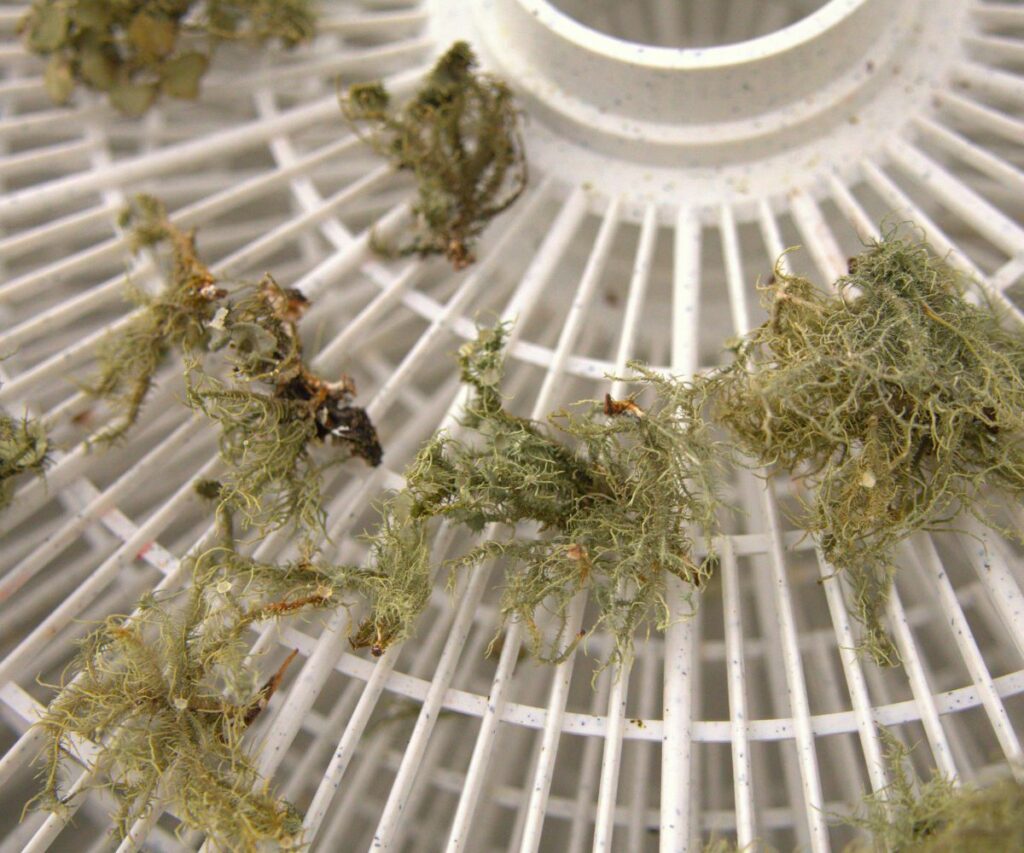
4. Measure Up
This usnea tincture requires a plant-to-solvent ratio of 1:5. To achieve this ratio, we will use equal parts water and alcohol, beginning with the alcohol and adding water during a decoction phase.
Once your usnea is dry, measure it on a kitchen scale and multiply its weight by 2.5 to determine the amount of alcohol you need. Here’s an equation you can use to make it easier:
(usnea weight X 2.5) = alcohol volume
For example, I’m starting with two ounces of usnea, so I’ll need to add five ounces of alcohol.
During the water decoction phase, I’ll add the same amount of water to make the 1:5 ratio.
5. Add Alcohol and Leave for Extraction
Pack your usnea in a Mason jar and pour the alcohol over it slowly. It will likely expand as it takes on liquid; in that case, pack it back down again.
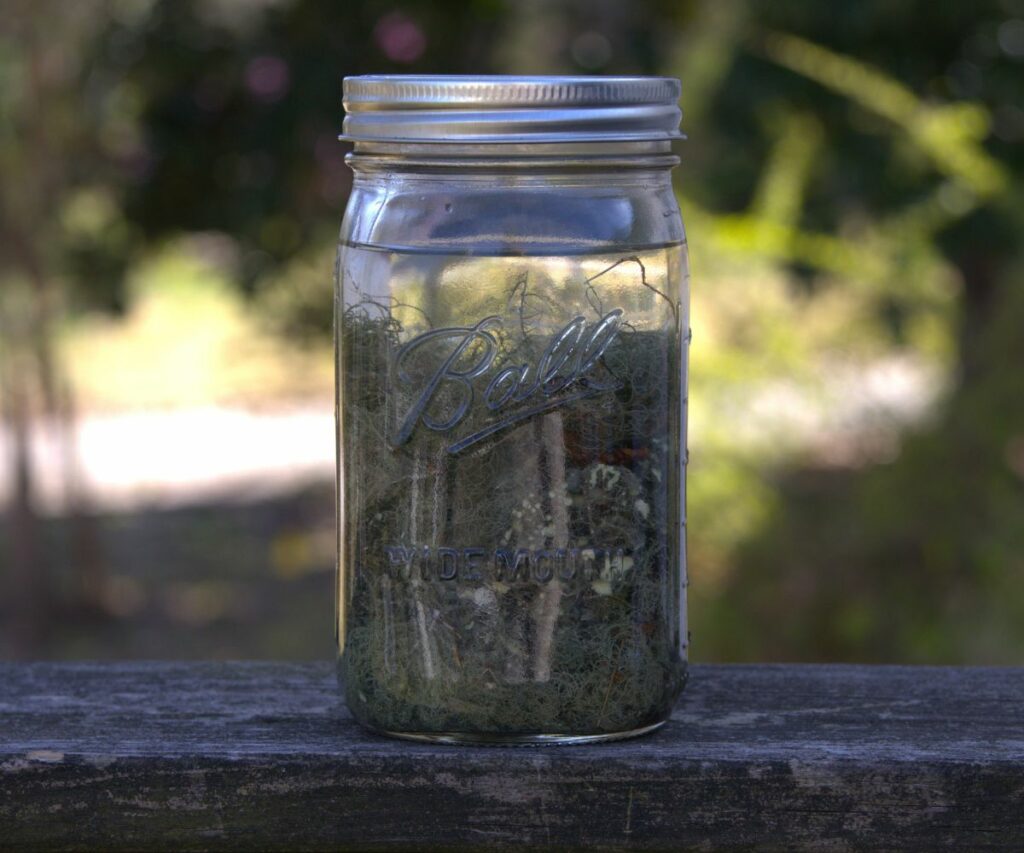
Place your usnea tincture in a cool, dark place to infuse for 4–8 weeks. Four weeks should be sufficient if you’re working with powdered lichens. More time is better if you leave the lichens whole.
Your mixture will turn brown, reddish, or coppery depending on the species. Usnea is often used as a natural dye and will turn the solvent into beautiful and sometimes brilliant colors!
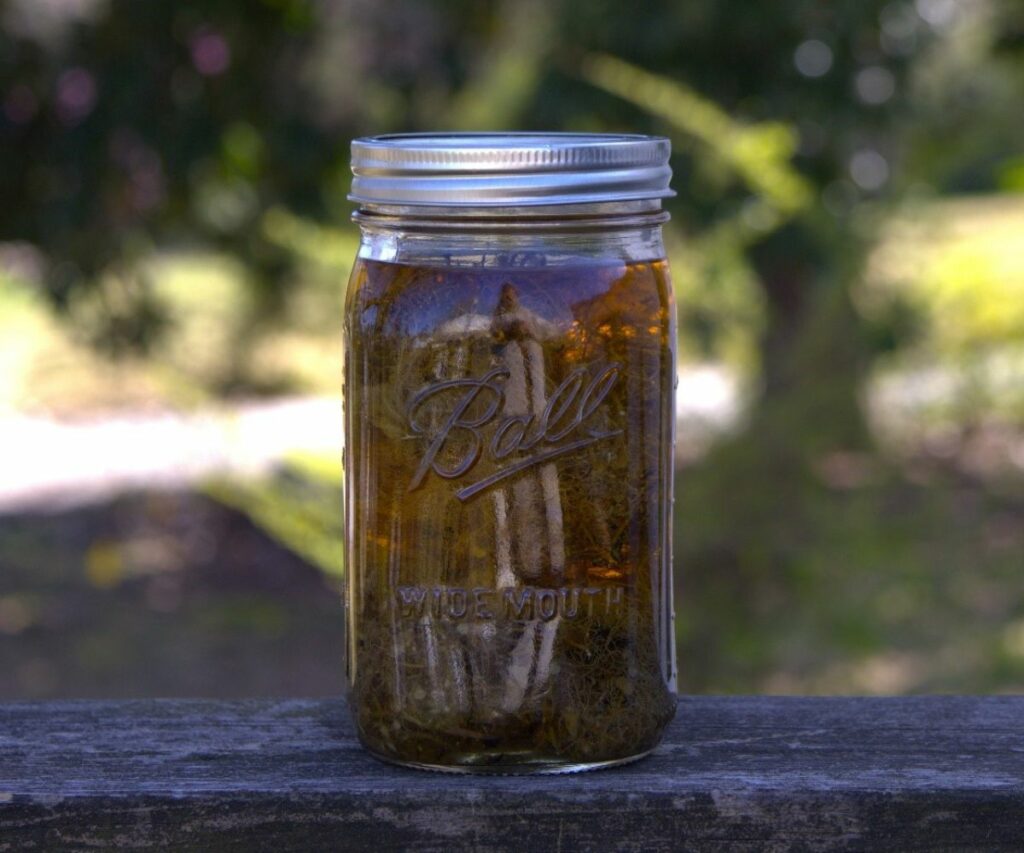
6. Strain
Once several weeks have passed and your solvent takes on a nice color, you’ll separate the plant matter from the alcohol.
Strain the liquid out over another Mason jar and press the lichen well to remove as much alcohol as possible. Put a lid on the jar of alcohol and set it aside.
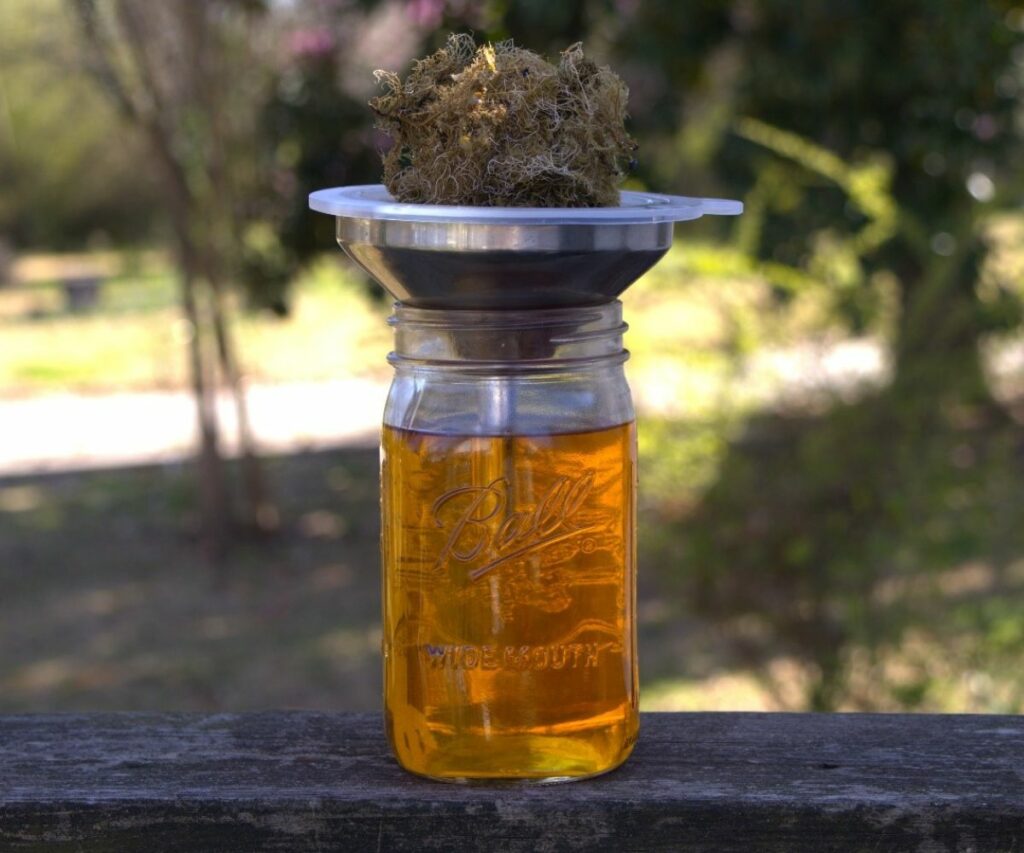
7. Add Water and Decoct
Remember how much alcohol you used? Go ahead and measure out the same amount of water for this step.
Place the usnea lichen in the bottom of your crockpot and cover it with water. I always add another half-ounce since heat makes water evaporate, even in a crockpot. The lichen will also soak up some of the water, so it’s best to have a little extra.
Turn the crockpot on the “low” setting for one hour, then change it to the “warm” setting. Leave it at least 12 hours and up to 24 hours. Some people leave it up to three days. If you want to go this route, add another half-ounce of water each day it sits in the crockpot.
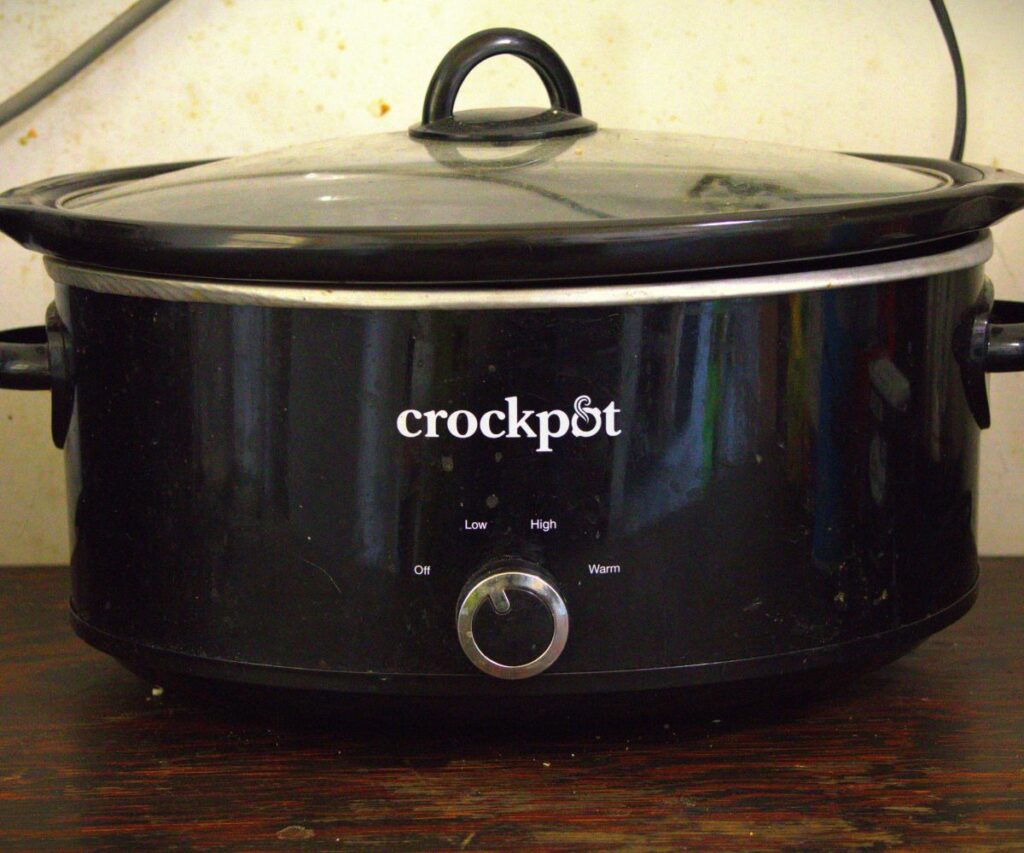
What if you don’t have a crockpot? No problem. You can put the usnea in a stove pot with water. Set your stove to a low setting, add an extra half-ounce of water, and leave it to decoct for 2–12 hours.
Make sure to keep a lid on the pot at all times to prevent as much evaporation as possible.
8. Strain
Once your hot water extraction is complete, your water will take on a brownish, swampy hue. It’s not nearly as pretty as the alcohol solvent, but it is very medicinal.
Strain out the plant matter over a mason jar and get ready to combine!
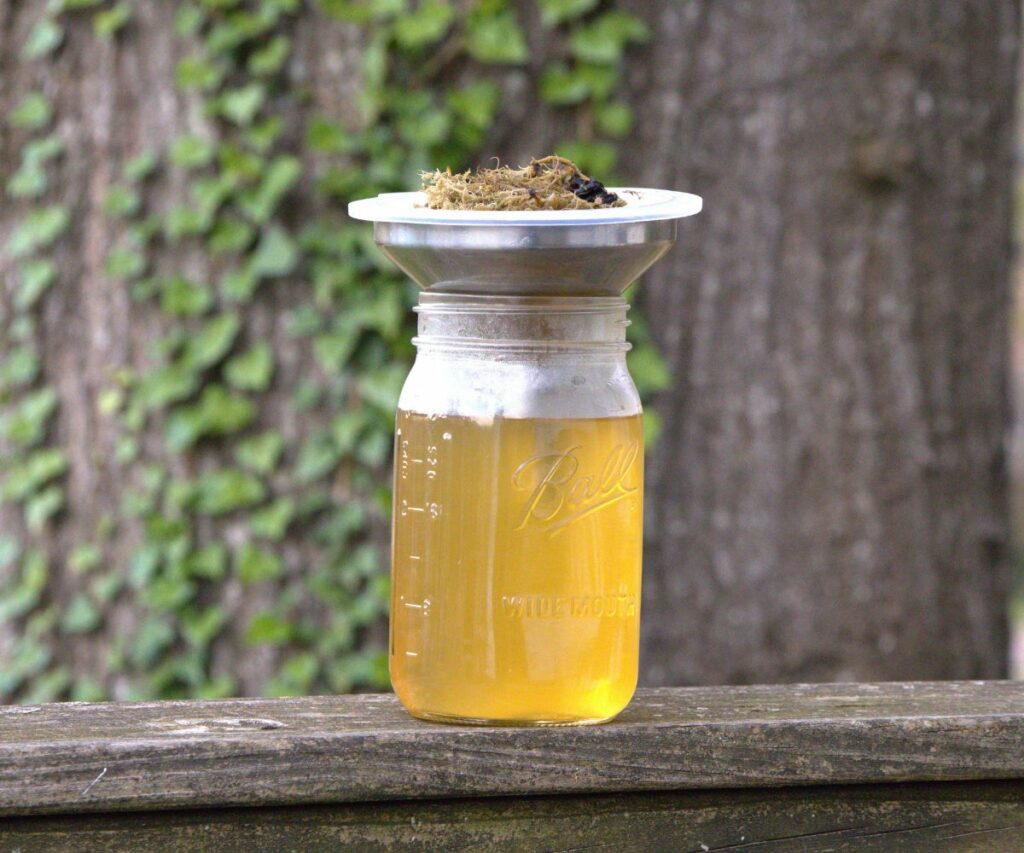
9. Combine Extractions
At this stage, you have a jar of alcohol and a jar of water extract. They should be roughly equal in volume. If they’re off by a bit, it’s no big deal.
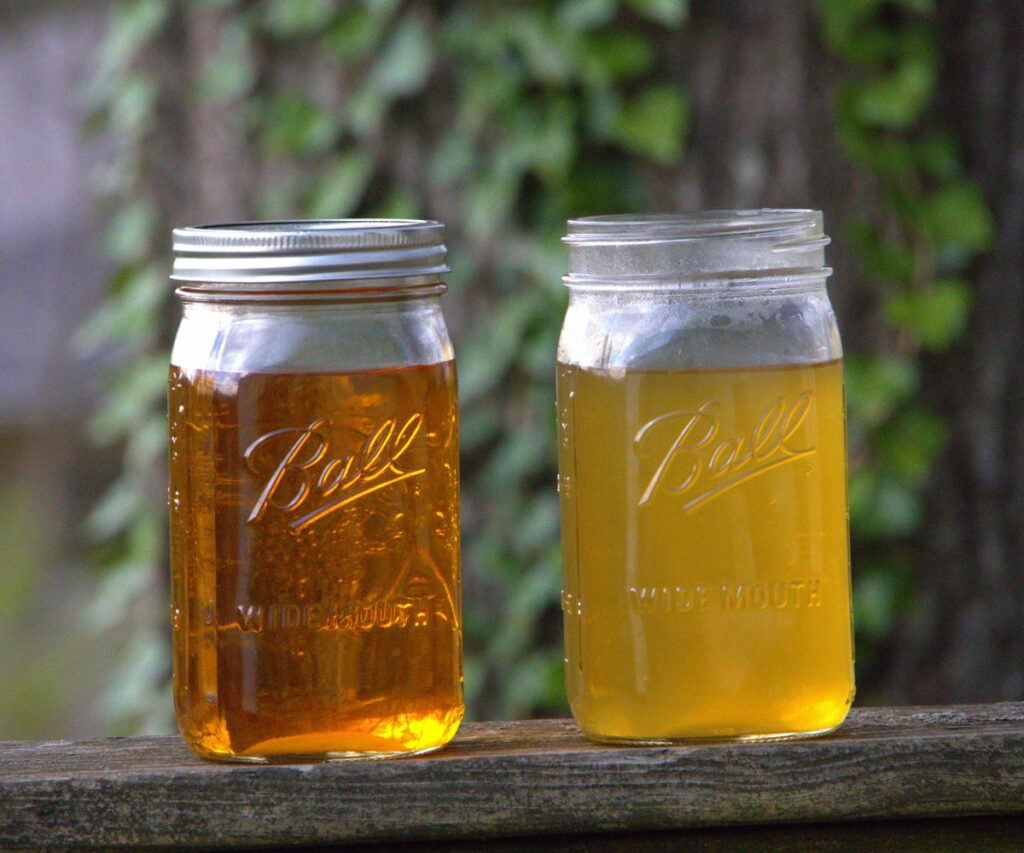
Grab your third Mason jar to combine it. Add the alcohol first, then pour in the same amount of water and watch the magic happen.
The combination will bubble slightly, producing a cloudy, opaque, light-colored liquid.
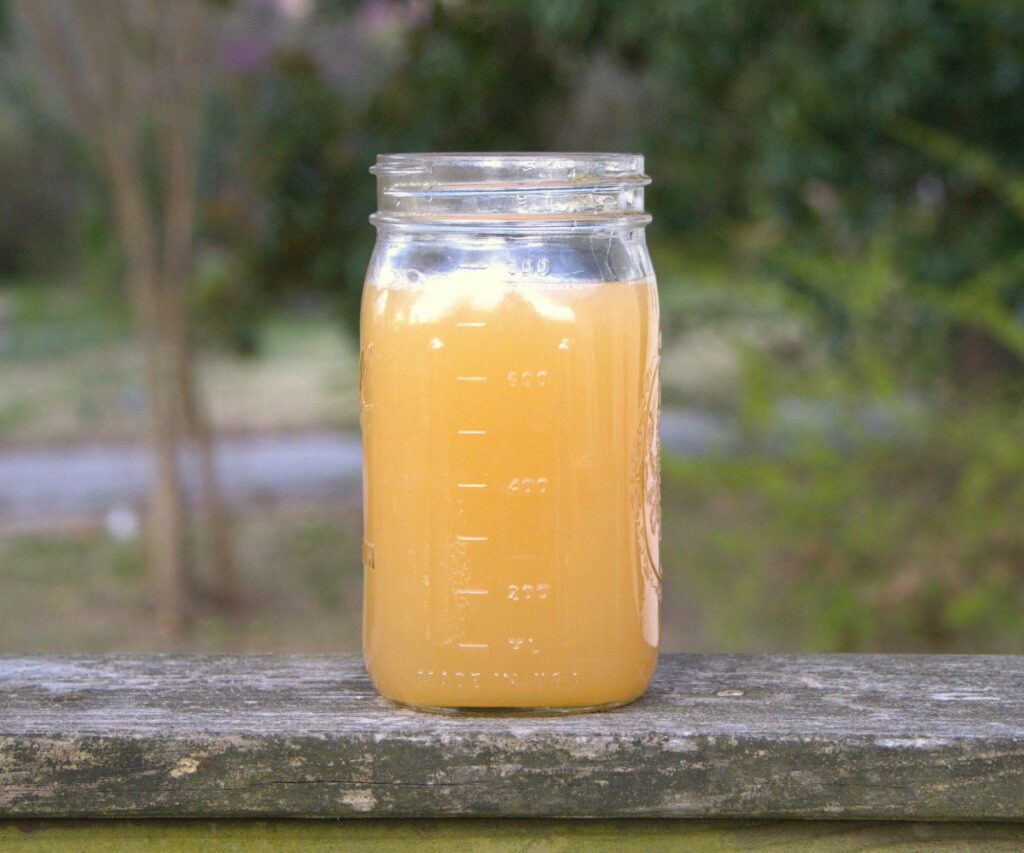
10. Store Properly and Enjoy!
Once you have combined the alcohol and water extractions, you’ll have a dual-extracted usnea tincture!
All that’s left to do is store it correctly.
It’s best to bottle your tincture in dark blue, black, or amber-colored tincture bottles. Glass is better than plastic because it won’t leach into your medicine.
Using dark-colored glass will block UV rays and heat, preventing the tincture from degrading over time.
Since you started with 190-proof alcohol, your mixture should contain between 35%–45% ABV. This means it is shelf stable and will stay good for 3–5 years.
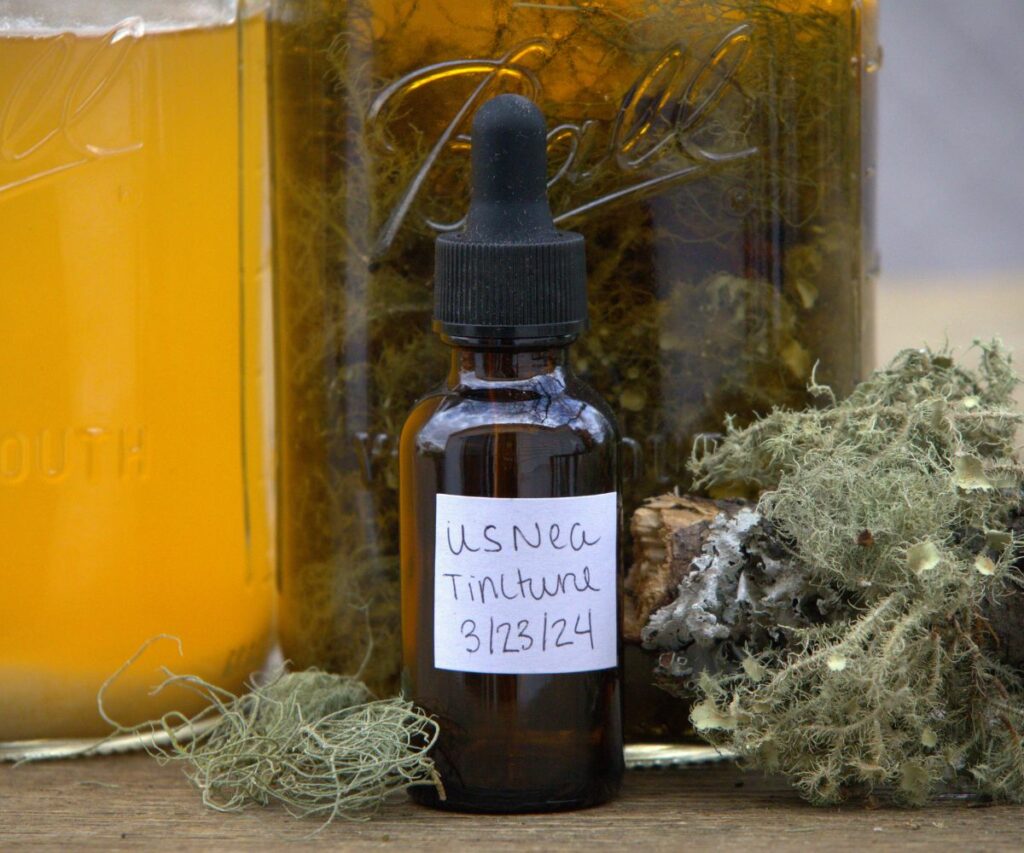
Usnea Tincture Dosage
The most popular way to use usnea tincture is orally for internal infections. Although it’s an excellent treatment for existing infections, it is not a preventative.
I don’t recommend taking usnea every day since usnic acid can cause liver toxicity in high amounts.
The elderly, children, those with serious underlying health issues, and pregnant or breastfeeding women should not take usnea tincture at all because of this risk.
Preparing a tincture at a 1:5 ratio will result in about 200 mg/ml of dry plant matter. This is a safe daily regimen, considering that animal studies report no toxicity at this amount.
Problems and eventual lethality occur at much higher doses of between 7 and 20 grams daily.
For healthy people, low doses of up to a milliliter per day should be fine. To stay safe, it’s always best to ask your doctor before supplementing with usnea or any medicinal plant.
Usnea tincture can also be used externally as an antifungal to fight ringworm and other mycotic infections. It is also helpful as an antiseptic to clean and sanitize wounds, scrapes, and bites.
Be warned: the high alcohol content makes application to broken skin painful, so avoid using tinctures externally unless no alternative is available. An usnea powder is easier to make and much more comfortable to apply!
Usnea lichen serves many medicinal purposes on the homestead. Now that you know how to make an usnea tincture the right way, you’re ready to harness the true potential of this lichen today!

